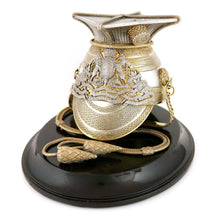The 16th (Queen’s) Lancers - Silver Gilt Czapka Inkstand, 1876
- Regular price
- £15,000
- Sale price
- £15,000
- Regular price
-
- Unit price
- /per
Adding product to your cart
Height: 13.9cm (5.5in) x 21.5(8.5in) x 17.7cm (7in)
Silver and silver gilt. An exquisitely modelled inkwell in the form of an officer’s full dress lancer cap; with trencher top, rosette with ER cypher to the upper left quarter, opening at the waist to reveal an inset glass inkwell, over the skull modelled with bands of lace, and fitted with gilt acanthus leaf hook to the rear for the curb chain, and gilt lion’s masks ear bosses to the sides, the front applied with rayed helmet plate featuring the royal arms and battle honours Talavera to Relief of Kimberley. Maker’s mark of Edward H. Stockwell. Hallmarked London 1876. Mounted on its original ebonised base supporting artfully coiled caplines.
Read more
The present czapka inkwell belongs to a small group of inkwells modelled on Victorian cavalry headdress by Edward Stockwell. Known examples are two Life Guards 1871 Pattern Helmets, and a finely chased Hussar busby with similarly coiled cap lines. The present example was clearly a cherished object within the context of the regimental history and as such was maintained to reflect important events, specifically the succession of Edward VII to Queen Victoria and the granting of new Battle Honours won in the South African War (1899-1902). Moreover by 1909 the 16th had won more than any other cavalry regiment in the Army. Just as all officers lance cap plates were updated so too was the present inkwell with inclusion of the Battle Honours for Paardeberg and Relief of Kimberley. On the morining of the Relief of Kimberley two squadrons of the regiment performed one of the most satisfactory cavalry actions of the war with a charge at Klipt Drift to clear the ‘knek’ between two hills, of the enemy who were swept away in all directions.
The British Lancer Officer’s lancer cap, or czapka as it became known, is considered among the most impressive of all military headdress. It derived from the Polish lancer headgear which in turn was inspired by national four-cornered cap known as the Tschapka or Confederatka. During the Napoleonic Wars, Polish lancers repeatedly showed their value as shock troops, and were recruited into the service of Austria, Prussia, Russia, and most famously France, in Napoleon’s Imperial Guard as the 1er Regiment de Chevau-Legers-Lanciers de la Garde Impériale. Lancers of all European armies were distinguishable by the czapka. They were tall, colourful and bedecked with gold bullion loops. At Waterloo French lancers proved themselves so terrifyingly efficient that afterwards several British light dragoon regiments were converted to lancers. Moreover, General Durutte, commanding the French 4th Division from the high ground in front of Papelotte Farm, noted, ‘I had never before realized the great superiority of the lance over the sword.’ Consequently the czapka was worn in battle in northern India by the 16th (Queen’s) Lancers in 1846 at Aliwal (under a white cover) and by the 17th Lancers at the famous charge of the Light Brigade against the Russian guns at Balaclava in 1854.
Working from 1865 to 1894 in London, silversmith Edward Henry Stockwell (b.1840), continued his father’s Soho business and was renowned as a maker of decorative works of art, luxury items and practical pieces. His objects of vertu were retailed by top luxury goods firms of the day - Walter Thornhill, 144 New Bond Street; Henry Lewis, 172 New Bond Street; Alfred Clark, 20 Old Bond Street; and Leuchars & Son, 38 & 39 Piccadilly and Paris. His catalogue further included top quality vesta cases, scents and decorative additions for decanters, but he is, perhaps, best known for sculptural work notably the detailed naturalistic forms of flowers, animals and birds that clearly demonstrate the quality and abiding attraction of this silversmith’s art and skill. In 1876 he was awarded a competition prize by The Worshipful Company of Goldsmiths for presentation casket design. Stockwell’s 15 Greek Street workshop was taken over during 1894 by William Tietzsch - ornamental gold, silver and metal manufacturer who may have carried out the work on the Edwardian royal arms and battle honours.












